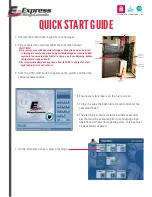
4
Telescope Balancing Operations.
To correctly balance the telescope it must be
free to move manually around both
rotational
axes.
A significantly unbalanced mount can cause the telescope to drop quickly with potential
damage to the tube or to the mount itself. To prevent this from happening when using the mount
in Equatorial mode, be sure to hold onto the tube with the hands before loosening the clutch
knobs if the telescope has not been balanced, especially in the DEC axis.
To guarantee correct and reliable mount tracking it is necessary to balance the telescope in both
rotational
axes. Even if the telescope is not intended to track in Declination, the optical tube
must still be balanced in this axis to avoid sudden movements when the DEC clutch is
loosened. This precaution also helps to limit vibrations and to provide immediate response
during auto-guided photographic sessions.
4.1 Declination Axis Balancing
With the M-zero LHQ mount it is better to balance the DEC axis first because the RA axis will
already be almost balanced.
1. Put the telescope in a horizontal position.
2. Loosen the DEC axis clutch
knob and allow
the tube to move –
GRADUALLY
– to
verify in which
direction
it tends to move.
3. Slightly loosen the knob on the mounting
saddle that keeps the dovetail bar and the
telescope fixed to the mount. Next slide the
tube forward or backward and tighten the
saddle knob. Repeat this action until the
mount stays in the same horizontal position
even with the DEC axis clutch completely
loosened. This stability indicates that the
telescope is balanced in the DEC axis.
4. Tighten the mounting saddle knob and the DEC clutch knobs to lock the telescope in the
balanced position.
5.
DO NOT
let go
of
the tube until the mounting saddle knob and DEC clutch knobs are
firmly tightened.
©
All Rights reserved
21














































